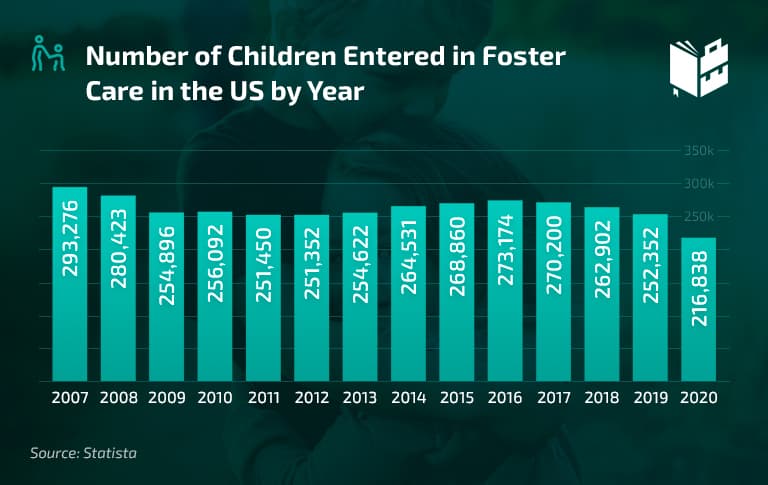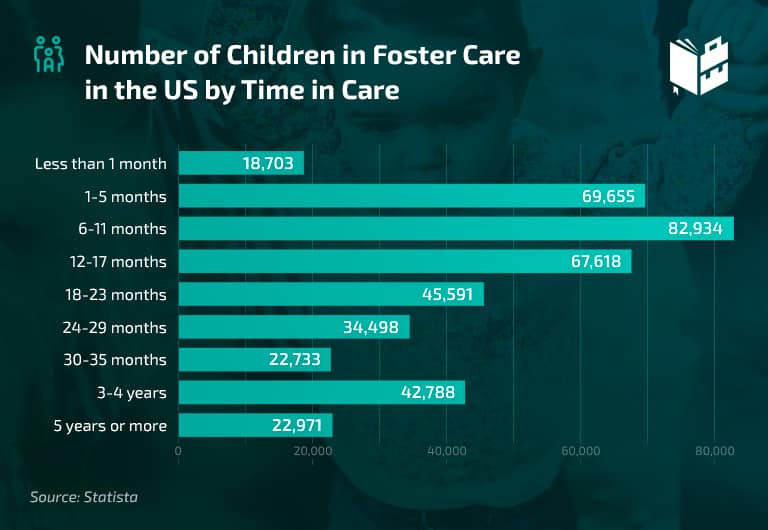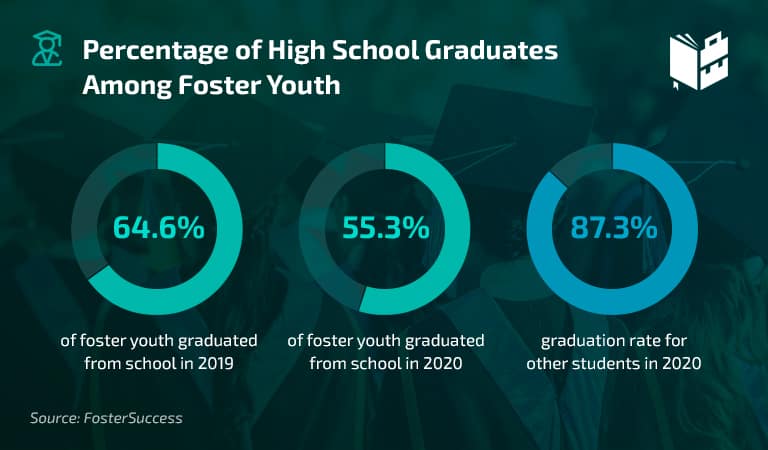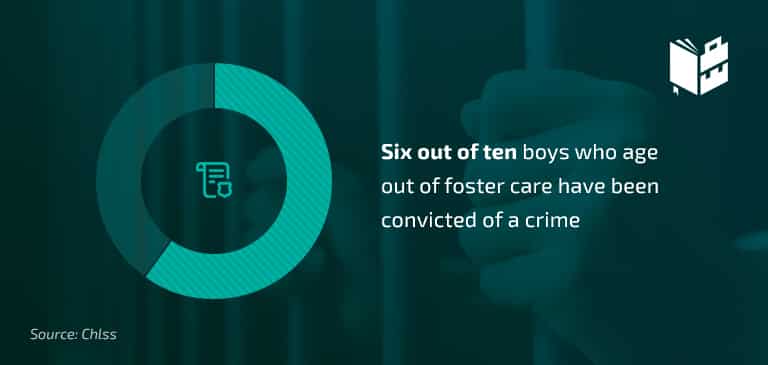It can be inferred from foster care education statistics that living in foster care affects a child in many ways. Whether it’s because of the frequent transfers from one foster home to another or separation from siblings, the child will be emotionally affected all the same.
Ultimately, these factors will influence their school performance negatively. To prove our point and raise awareness, we’ve compiled a list of stats regarding foster care education.
Interesting Foster Care Statistics (Editor’s Choice)
- The median age of foster children is 6.1 years.
- The number of foster youth nationwide is 407,493.
- 13–38% of foster students who finish high school choose to attend higher education.
- Foster kids are suspended and expelled from school three times more often than other children.
- Foster youth is less likely to graduate from high school.
- Between 2% and 10.8% of foster care alumni have a bachelor’s degree.
- 20,000 children between 18 and 21 age out of the system yearly.
- 50% of foster children have no earnings within four years of aging out, and those who do have an average annual income of $7,500.
Foster Care Education Statistics
1. The number of foster youth nationwide is 407,493.
(Children’s Bureau)
The number of foster children has been increasing yearly, despite the best efforts of Child Protective Services to prevent the children’s removal from their parents. As a result, there is a high demand for foster parents in nearly every city across the US.
2. There are more male than female children in foster care.
(Children’s Bureau)
The number of children in foster care in the US based on gender is close to equal. However, there were more male than female children in foster homes in 2020. More precisely, a Children’s Bureau report shows that there were about 209,063 male foster children compared to 198,387 female foster children.
3. 216,838 children entered the US foster care system in 2020.
(Statista)
According to the latest data available on foster care education stats, the average number of children entering the US foster care system has changed over the years. In 2007, statistics showed that the total number of kids entering foster care reached its all-time high, standing at 293,276. That number continuously declined until 2012, after which it increased to 273,174 in 2016. It ultimately dropped to 216,838 in 2020.

Foster Care System Facts
While learning about statistics related to the education of foster care children is imperative, knowing some facts about the foster care system is also a must. Let’s dive deeper into the topic.
4. The median age of foster children is 6.1 years.
(iFoster)
Despite the widespread belief that most foster children are abandoned or taken from their families as babies, the median age of foster children is 6.1 years. According to foster children and education statistics, children of all ages, from infants to 21-year-olds, are part of the foster care system worldwide.
5. Eight out of 1,000 US children experience abuse or neglect.
(Children’s Bureau)
There are several reasons Child Protective Services would remove a child from a family home, and some are more severe than others. Among the most common ones are mental, physical, or sexual abuse and neglect.
According to national foster care statistics, eight out of 1,000 American children are victims of domestic abuse, sexual abuse, or neglect during their childhood. Children who are younger than one year are the most vulnerable group, with 25 out of 1,000 experiencing the said abuse.
6. 22,971 children in foster care were in the system for five years or more.
(Statista)
In 2020, 69,655 children spent 1–5 months in foster care, 67,618 were there for 12–17 months, and 22,971 spent five years or more in the system, based on statistics on foster care and education.

7. In 2018, 22,543 kids entered the California foster care system.
(KidsData)
Data about foster care show that the average rate of children entering foster care for the first time in California was 2.4 per 1,000 in 2018 for children aged 0–17. Although that number doesn’t seem high, it corresponds to 22,543 children entering the foster care system, according to California foster care statistics.
8. 20,000 children between 18 and 21 years old age out of the system yearly.
(iFoster)
The exact age when children become too old for the system depends on the country. Still, 20,000 young individuals exit foster care yearly because they become adults. Left to their fate, these kids have to learn to provide for themselves. As a result, education becomes less important than working for many of them.
Foster Care High School Graduation Rate
Many individuals believe that there are significantly fewer foster children who graduate from high school than children who never experienced foster care—and they are right. Let’s go over the statistics regarding this topic.
9. Foster care students are less likely to graduate from high school.
(FosterSuccess)
High school statistics show that only 55.3% of foster youth graduated from school in 2020. In 2019, the overall foster care graduation rates stood at 64.6%. Compared to an overall graduation rate of 87.3% for other students that year, it’s a significantly lower percentage.

10. Only 21% of urban and 5% of rural foster youth have access to a computer at home.
(iFoster)
In 2022, having access to a computer is crucial for any student. However, the majority of foster youth don’t have access to technology at home. It can be inferred from foster care education stats that without easy access to laptops or smartphones, foster kids are restricted in many areas, such as studying, job application, and extracurricular activities. Therefore, these students are at a disadvantage from the start and are more likely to fail or barely pass their exams.
11. High school dropout rates are three times higher for foster youth than other low-income children.
(NFYI)
According to foster youth and education statistics, high school dropout rates are three times higher for foster youth than other low-income children. One of the common reasons cited is the frequency at which these children change homes. Ultimately, we believe that for the dropout rate to improve, foster children need better guidelines and more support to meet academic requirements that will help them land better jobs in the future.
Effects of Foster Care on Education
Foster children’s education is severely affected. As such, we’ve compiled a list of statistics that focus on this particular issue. All of these stats will explain how being a foster child negatively influences a child’s growth and career prospects.
12. Foster kids get suspended and expelled from school three times more often than other children.
(Partners For Our Children)
According to foster youth education statistics, children in foster care have different needs and backgrounds than their peers. Many of these children come from abusive households, making them prone to erratic behavior that ultimately leads to suspension or more severe disciplinary measures.
13. Foster kids’ success rates in meeting mathematics, science, and English standards are less than half the rates of other children.
(Partners for Our Children)
Experiencing foster care is often associated with underperformance in school, dropping out, and not pursuing higher education. Based on foster care education facts, foster care students meet state standards in mathematics, science, and English at less than half the rate of other children.
14. One out of four foster kids show signs of post-traumatic stress disorder.
(SpeakUpNow)
PTSD, also known as post-traumatic stress disorder, is a huge issue when talking about foster children. Research has shown that at least 25% of the overall number of foster youth in the US suffer from this mental health condition.
15. Six out of ten boys who age out of foster care have been convicted of a crime.
(Chlss)
As dire as these statistics are, they are indeed true. 60% of the total number of young male individuals are convicted of at least one crime after exiting foster care because of their age, according to aging out of foster care and education statistics.

16. Being a child in foster care increases the frequency of mid-year school changes and decreases the total number of days children spend in school.
(Partners For Our Children)
Foster children change schools more often than other students. Moving to a new school is never easy on a child, let alone if it happens mid-year. These transitions affect children in more ways than one.
Foster Care Outcomes Statistics
Despite the big failure rate, there still are many foster children who do complete high school and decide to pursue higher education.
17. 50% of foster children have no income within their first four years of aging out, and those who do have an average annual income of $7,500.
(iFoster)
The inability to find a job or afford a home is a significant problem these children face once they age out of the system. As foster care and education statistics show, most of these kids have no idea what it takes for an individual to be self-reliant. Moreover, many foster care children don’t possess the skills required to land a high-paying job.
18. Only 13–38% of foster students who graduated high school aspire to pursue higher education.
(ABA)
Significantly fewer children in foster care go to universities because many of them aren’t financially stable, which can be inferred from foster care success statistics. Based on education statistics, low-income children don’t attend college mostly because of financial problems.
19. Between 2% and 10.8% of foster care alumni have a bachelor’s degree.
(ABA)
Obtaining a bachelor’s degree has become essential to any individual to land a good job. However, not everyone has the means necessary to do so. Unfortunately, foster children, in particular, are at a disadvantage. More precisely, foster care college statistics show that only 2–10.8% of foster care alumni have a bachelor’s degree.
Conclusion
Given the statistics listed above, foster kids are at a disadvantage from the start compared to other kids in terms of education.
Multiple factors have a significant impact on foster children’s academic performance, such as school transfers, disrupted school attendance, lack of access to mental health services, financial problems, and so forth.
After closely examining foster care education statistics, we concluded that there is much room for improvement in foster children’s education. Creating a safe environment where foster students won’t feel threatened is a good starting point. It’s imperative we provide them with not only emotional and financial support but also guidance and much-needed advice. Only then can we expect a more positive outcome and brighter future for all.